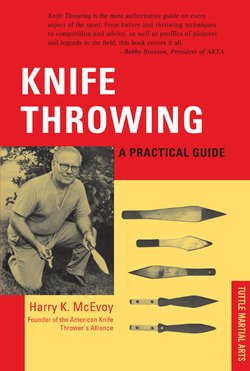Читать книгу Knife Throwing - Harry K. McEvoy - Страница 11
На сайте Литреса книга снята с продажи.
ОглавлениеCHOICE OF WEAPONS
As every sportsman knows, regardless of his favorite sport, a high degree of achievement is more easily attained if the sportsman is using the best equipment he can get. Top performers in the fields of archery, skeet, trap, golf, and tennis, to mention only a few, use the finest tools of their sport they can afford. In most cases this pays off in extra dividends of personal satisfaction and increased skill.
The same is true of knife throwing.
Not every knife is suitable for throwing. The elements of length, weight, and balance in a proper combination of all three determine just how good the weapon is for throwing, regardless of whether it is designed to be hurled by handle or by blade.
First and foremost is to have a knife that is properly balanced for throwing. Next in importance is weight, in proportion to balance and length, for the knife must have enough "heft" to enable it to penetrate and stick in the target. And finally, it must be long enough to give the knife thrower maximum control over his throw.
The "rule of thumb" method in selecting a good throwing knife is to pick one which weighs approximately one ounce for every inch of overall length. The recommended limits for the most efficient throwing-knives are from 10 to 15 inches, with corresponding weights from 10 to 16 ounces. Knives over the one-pound limit require a thrower with a very strong pitching arm.
The most important factor, however, is that of balance. For instance, a knife may be perfectly balanced for the job for which it was designed, such as the delicate task of skinning or dressing out game, but it may be balanced incorrectly for chopping lettuce or slicing bread.
A good throwing-knife has to be balanced for throwing. If it is designed to be thrown by the handle, point first, the pointed end is the heavy end, with the balancing point at the approximate overall center, or up to one inch back of the center. With this type of knife the thrower will hurl the weapon for one, two, or even several spins to strike his target point first (Fig. 2).
If the knife is designed to be thrown by the blade, it will usually resemble a slim-bladed hunting knife with a light point and heavy handle. In this style weapon the balancing point should be within an inch either way of the hilt or crosspiece dividing the blade from the handle. With this type of throwing-knife, the thrower will have 1/2 spin, 2 1/2 spins, 2 1/2 spins, etc., to hurl his blade into the target point first (Fig. 3).
Of the two types, it is easier for the beginning knife thrower to start with the handle-throwing style since only even spins are involved. But when he also masters the type hurled by the blade, handle first, he will greatly enjoy throwing it, even though it is more difficult to stick squarely. This difficulty is caused by the weight of the rapidly spinning handle which on an imperfect throw or slightly misjudged distance may flip the knife up and out of the bull's-eye.
For best results the heavy end of a throwing-knife should always be thrown first, with the lighter end gripped by the hand. In this way the thrower can hurl his weapon with maximum force and velocity and at the same time have better control for accuracy.
There are a few rare throwing-knives that can be hurled equally well by handle or blade. Knives of this type are especially designed as "game getters" or "combat throwers," and are used for hunting game with a throwing-knife or for military combat emergencies (Fig. 4). Some professional types, such as the one designed and used by Paul LaCross, the great professional knife thrower, are also perfectly balanced to be thrown equally well by handle or blade (Fig. 5). These knives are balanced at approximately dead center of the overall length and are superbly designed to achieve the right combination of length, weight, and balance.
The most important point to remember, however, is to select a knife designed and balanced for throwing, between 10 and 15 inches overall, with a recommended length at around 13 1/2 inches. The weight of the knife should average approximately one ounce for every inch of overall length, regardless of which type you choose. A throwing-blade that meets the above specifications is usually a good one for the sport. After he gets his knife, the rest is up to the thrower.
